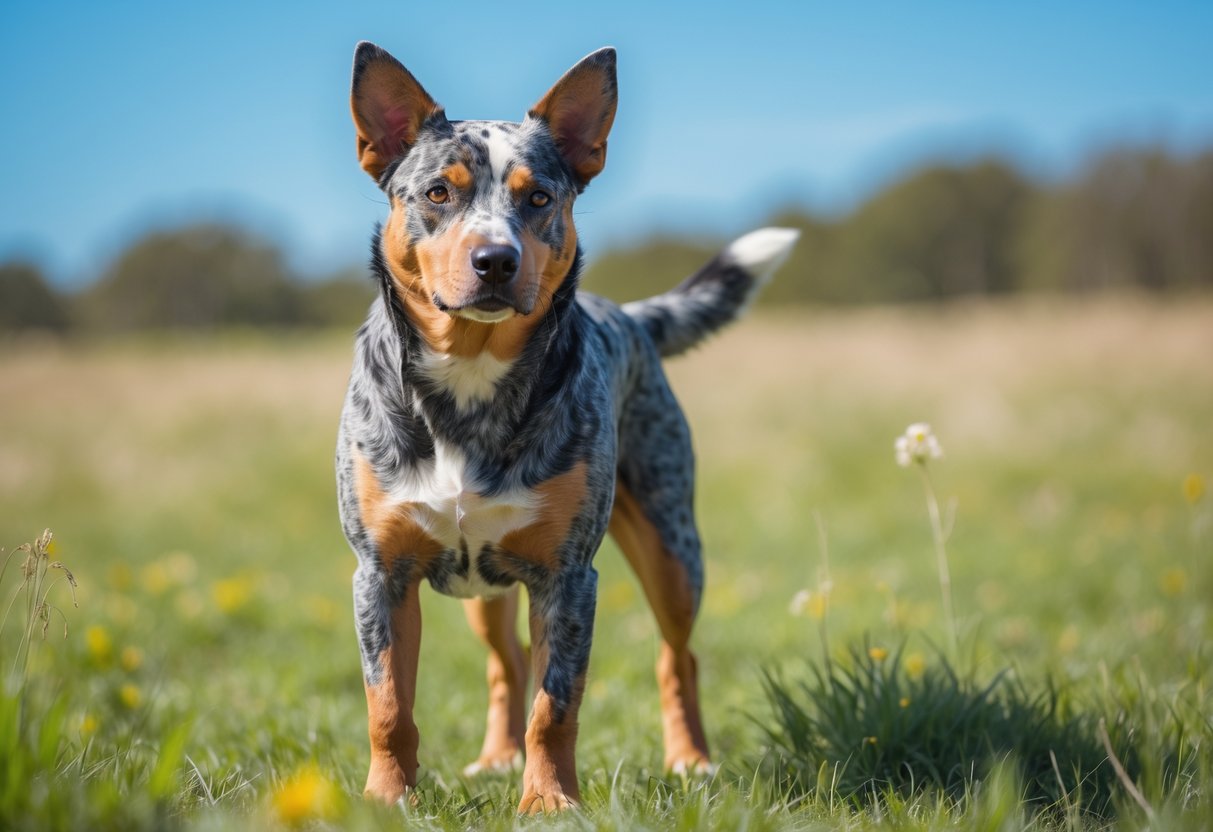Australian Cattle Dog: Essential Guide to Care and Training

The Australian Cattle Dog is a strong, smart, and hardworking breed developed to herd cattle across tough Australian terrain. It is well known for its loyalty, intelligence, and high energy, making it a great choice for active owners who can meet its exercise needs.

This medium-sized dog has a dense, weather-resistant coat that comes in red speckle or blue, which protects it during long days outside. Beyond its physical strength, this breed is also famous for its remarkable lifespan, with some living well into their late twenties.
Its natural instincts and protective nature make the Australian Cattle Dog a unique working companion, well-suited for jobs that require focus and endurance. Learning about its history and care can help owners provide the right environment for this special breed.
History and Origin

The Australian Cattle Dog was created to handle tough cattle herding in harsh Australian conditions. Its development involved specific breeds chosen for stamina, intelligence, and herding ability. This dog became widely recognized both in Australia and internationally for these traits.
Development of the Australian cattle dog
The breed began in the early 19th century, around the 1820s. Australian stockmen needed a dog that could work with cattle on large, rugged land. The initial goal was to create a durable dog that could control cattle by nipping at their heels.
Breeders focused on working dogs that could endure long days outside. The Australian Cattle Dog’s ancestors were selectively bred over decades to increase stamina, intelligence, and alertness. By the 1840s, this new type of herding dog was proving reliable on cattle stations.
Influential Breeds
The Australian Cattle Dog’s key ancestors include herding dogs from Britain. Collies and other working dogs contributed to its intelligence and herding instincts.
The breed also has some Dingo ancestry. Dingoes lived wild in Australia, and it is believed abandoned Dingo puppies were raised by settlers and bred with domestic dogs. This gave the breed strong physical traits like endurance and a short, weather-resistant coat.
The mix created a dog well-suited to Australia’s climate and rough work. Colors like blue and red speckled coats come from the mix of these different breeds.
Recognition in Australia and Abroad
The breed was officially recognized in Australia in the early 20th century by kennel clubs. It became known as the “Australian Cattle Dog” or “Blue Heeler.”
International recognition followed as the dog’s skills were noticed by cattle ranchers in other countries. Today, the Australian Cattle Dog is respected worldwide for herding, obedience, and loyalty.
It remains a popular working dog and pet, valued for its strong work ethic and intelligence.
Physical Characteristics

The Australian Cattle Dog is a strong and agile breed. It has a distinct appearance shaped by its work as a herding dog. Size, coat, and unique features all play a role in its identity.
Size and Build
The Australian Cattle Dog is medium-sized and well-muscled. Males typically weigh between 35 and 50 pounds, while females range from 30 to 45 pounds. Their height usually falls between 17 and 20 inches at the shoulder.
The breed has a compact, sturdy frame. It is built for endurance and agility needed in herding cattle over rough terrain. Their body is balanced with a deep chest and strong legs, suited for long hours of work.
Coat Colors and Patterns
The coat is short, dense, and weather-resistant, designed for outdoor work. There are two main color types: blue and red.
- Blue Heeler: Blue-gray with possible black, tan, or mottled markings.
- Red Heeler: Red speckled with darker red or tan markings.
Both variations have a thick undercoat and smooth outer coat. These colors help the dog blend well into farm environments.
Distinguishing Features
The breed’s ears are triangular and stand upright, adding alertness to its expression. Its head is broad with a strong muzzle and intelligent eyes.
Australian Cattle Dogs have a tail that is low-set and typically hangs down with a slight curve. Their paws are sturdy, with a tough pad that supports long hours of walking or running.
These features contribute to the breed’s hardworking and alert nature.
Temperament and Behavior

The Australian Cattle Dog is a working breed with clear traits linked to its job herding cattle. It shows sharp intelligence, strong energy, and distinct social habits shaped by its history and purpose.
Intelligence and Trainability
This breed is highly intelligent and learns quickly. It picks up commands and tasks faster than many other dogs. Because of its herding background, it often thinks independently but stays focused on goals.
Training needs to be consistent and firm. Harsh methods don’t work well because the dog responds best to respect and positive reinforcement. It thrives when given mental challenges, like agility or obedience classes.
Without an outlet for its sharp mind, the dog may develop destructive habits. Early socialization and training can prevent problems and build a well-mannered pet.
Energy Levels
The Australian Cattle Dog has very high energy. It requires a lot of daily exercise, including long walks and active play. Without enough activity, it can become restless or bored.
This dog is built for work, so it enjoys tasks that engage its body and mind. Herding, running, and problem-solving games suit it well. Calm indoor life alone is usually not enough.
Owners need to plan for at least an hour of exercise each day and provide toys or puzzles to keep the dog occupied when indoors.
Social Traits
Socially, the breed is loyal and protective. It often bonds strongly to family members and can be wary of strangers. Early socialization helps it behave calmly around new people.
It can get along with children if properly introduced and supervised. However, it may try to herd kids by nipping gently, a behavior from its working roots.
The dog generally coexists well with other pets if raised together but may show dominance or guarding tendencies around unfamiliar dogs.
Health and Care

Australian Cattle Dogs need specific care to stay healthy and active. Proper attention to their medical risks, diet, exercise, and grooming keeps them in good shape. They thrive with regular routines tailored to their energetic nature.
Common Health Issues
Australian Cattle Dogs can have some health problems linked to their breed. Hip dysplasia is common and affects joint movement, causing pain or lameness. Owners should look for stiffness or trouble walking.
Deafness appears at a higher rate in this breed, especially in dogs with lots of white coloring on their heads. Regular hearing checks are helpful.
Progressive retinal atrophy (PRA) can cause vision loss over time. Eye exams by a vet can catch this early.
Proper diet, exercise, and vet visits help handle these risks. Early detection can improve the dog’s quality of life.
Nutrition and Exercise Needs
This breed is very active and needs a balanced diet to match its energy level. Food should be high in protein and meet AAFCO standards to provide essential nutrients.
Avoid overfeeding to prevent obesity, which stresses joints. Measure meals and feed at regular times.
Daily exercise is critical. At least one hour of running, playing, or herding work helps keep them fit. Mental challenges like training games are also important.
Lack of exercise may lead to behavior problems or health decline because Australian Cattle Dogs are bred for physical activity.
Grooming Requirements
Australian Cattle Dogs have short, dense coats that protect them from harsh weather. They shed year-round, with heavier shedding in spring and fall.
Weekly brushing removes loose hair and prevents matting. A rubber curry brush works well.
Bathing is only needed when dirty to avoid stripping natural oils. Nail trimming every few weeks keeps paws healthy.
Check ears weekly for dirt or infection and clean gently if needed. Regular grooming helps spot skin issues or tick problems early.

Frequently Asked Questions
Australian Cattle Dogs are known for their strong work drive and intelligence. They require commitment in training, exercise, and socialization. Costs vary based on purchase and care, and they have specific behavior traits owners should be aware of.
